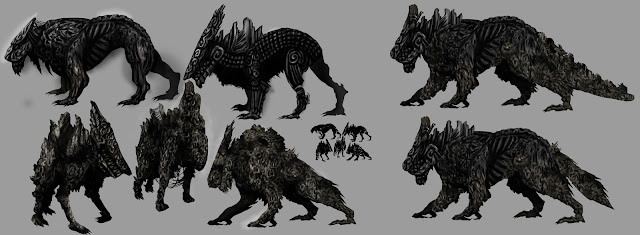Overview
Decided to revisit Feng Zhu's technique with red brush lineart, and design a disfigured monster.
Research/Inspirations
- Ludwig (Bloodborne boss)
- Envy's true form (Fullmetal Alchemist character)
Process
I drew a few loose designs, with no real idea to tie them together other than multiple limbs or eyes, or faces screaming in its flesh.
As I drew each small design I moved it to the edge of the screen, and eventually I began to see more designs in them overlapping than otherwise.
Each design was distinctly different, but so much so that I couldn't break down the design into elements I wanted to keep. The design floundered and I left it alone.
Reflection
- Without a basic direction, drawing aimlessly with lineart sketches is not the most efficient process
- Silhouettes might be best, like with the Gravestone Beast I designed
- Piling up lineart was unusually useful for this complex design, and gave interesting ideas - might be something to test later
Overall Reflection of All 10 Creature Designs and Artist Processes
- Silhouettes are very commonly used in different design approaches
- Lineart tends to work best with a more distinct idea, and to flesh out chosen silhouettes
- Using photo textures to enhance sketches gives a faster view of what the finished product might look like, and saves wasting time hand-drawing it in case it isn't chosen
- Simple backgrounds can be enhanced with small details like fog, keeping attention on the creature
- Varied line weights in line art makes it more interesting and hints at shadows
- With traditional sketches, brushpens help for silhouettes, and watercolours are exceptional for figuring out a colour scheme as it restricts colour choice and makes each decision count
- Research and reference images are key, especially kept on the page when drawing
- Visual libraries count for a lot - I think the reason I had trouble with the last design was because it didn't fit anything I had drawn before
Potential Next Steps:
- Find out what is best to have in a visual library for the most interesting creature designs
- Explore combinations of creatures to apply visual library to (i.e. bison/cat, dog/oryx)
- Look into mythological creatures and analyse the most common themes (i.e. wings, four legs) of popular and obscure creatures






